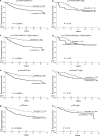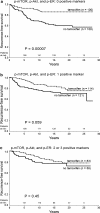Activation of Akt, mTOR, and the estrogen receptor as a signature to predict tamoxifen treatment benefit
- PMID: 23242584
- PMCID: PMC3539073
- DOI: 10.1007/s10549-012-2376-y
Activation of Akt, mTOR, and the estrogen receptor as a signature to predict tamoxifen treatment benefit
Abstract
The frequent alterations of the PI3K/Akt/mTOR-growth signaling pathway are proposed mechanisms for resistance to endocrine therapy in breast cancer, partly through regulation of estrogen receptor α (ER) activity. Reliable biomarkers for treatment prediction are required for improved individualized treatment. We performed a retrospective immunohistochemical analysis of primary tumors from 912 postmenopausal patients with node-negative breast cancer, randomized to either tamoxifen or no adjuvant treatment. Phosphorylated (p) Akt-serine (s) 473, p-mTOR-s2448, and ER phosphorylations-s167 and -s305 were evaluated as potential biomarkers of prognosis and tamoxifen treatment efficacy. High expression of p-mTOR indicated a reduced response to tamoxifen, most pronounced in the ER+/progesterone receptor (PgR) + subgroup (tamoxifen vs. no tamoxifen: hazard ratio (HR), 0.86; 95 % confidence interval (CI), 0.31-2.38; P = 0.78), whereas low p-mTOR expression predicted tamoxifen benefit (HR, 0.29; 95 % CI, 0.18-0.49; P = 0.000002). In addition, nuclear p-Akt-s473 as well as p-ER at -s167 and/or -s305 showed interaction with tamoxifen efficacy with borderline statistical significance. A combination score of positive pathway markers including p-Akt, p-mTOR, and p-ER showed significant association with tamoxifen benefit (test for interaction; P = 0.029). Cross-talk between growth signaling pathways and ER-signaling has been proposed to affect tamoxifen response in hormone receptor-positive breast cancer. The results support this hypothesis, as an overactive pathway was significantly associated with reduced response to tamoxifen. A clinical pre-treatment test for cross-talk markers would be a step toward individualized adjuvant endocrine treatment with or without the addition of PI3K/Akt/mTOR pathway inhibitors.
Figures



References
-
- Rodrik-Outmezguine VS, Chandarlapaty S, Pagano NC, Poulikakos PI, Scaltriti M, Moskatel E, et al. mTOR Kinase Inhibition Causes Feedback-Dependent Biphasic Regulation of AKT Signaling. Cancer Discov. 2011;1(3):248–259. doi: 10.1158/2159-8290.CD-11-0085. - DOI - PMC - PubMed
Publication types
MeSH terms
Substances
LinkOut - more resources
Full Text Sources
Other Literature Sources
Medical
Molecular Biology Databases
Research Materials
Miscellaneous

